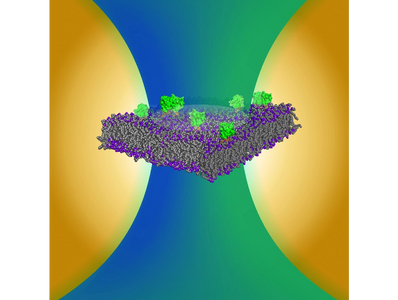Advanced Optical Microscopy
Our microscopy services include
- Designing and executing customized imaging needs
- Designing and building customized microscopes for specific needs
- Guidance in choosing type of microscopy and optimizing experimental protocols
- Strategies for sample preparation
- Quantitative image analysis
We are committed to helping you find the right tools and modalities to help you reach your goals in quantitative imaging and analysis

Fluorescence microscopy

Reflection interference contrast microscopy (RICM)
has the ability to measure interface distances with nanometer resolution. This technique is ideal for studying dynamic adhesion of soft materials, including biological samples.

Total internal reflection fluorescence (TIRF)
uses an evanescent wave to selectively illuminate and excite fluorophores in a thin region adjacent to the glass-water interface. This illumination method reduces background fluorescence signal and is suited to study events happening close to a surface, such as the cell membrane. It is also commonly used in single molecule tracking experiments.
Fluorescence recovery after photobleaching (FRAP)
By observing the rate and pattern of fluorescence recovery in a defined photobleached area, this technique is capable of measuring the diffusion and movement of biological macromolecules.
Fluorescence resonance energy transfer (FRET)
uses signals generated by energy transfer between two fluorophores. Because the transfer is limited to distances of less than 10 nanometers, the detection of FRET signals provides information about spatial relationships of the two fluorophores with sub-nanometer resolution. It has been used widely in studying protein conformation and protein-protein interactions, and can be used both in vitro and in live cells.
Confocal microscopy
By using a spatial filter to eliminate out-of-focus signal, confocal microscopy allows control of depth of field and enables ability of optical sectioning from thick specimens. The methods is particularly good at 3D imaging and surface profiling of samples.
Epi-fluorescence
most basic illumination method.
Transmitted light microscopy
Bright field
simplest form of light microscopy.
Dark field
image contrast comes from light scattered by the sample. Good for live and unstained samples
Phase contrast
mage contrast is enhanced by taking advantage of phase shift due to optical path difference through the sample. Live cells can be imaged in high contrast with sharp clarity in their natural state without being stained.
Polarized light
observing the rotation of polarized light through the sample
Differential interference contrast (DIC)
based on the principle of interferometry to gain information about difference in optical path length of the sample. DIC microscopy emphasizes line and edges and works great for live and unstained thin biological samples. However, it is unsuitable for thick samples, such as tissue slices.